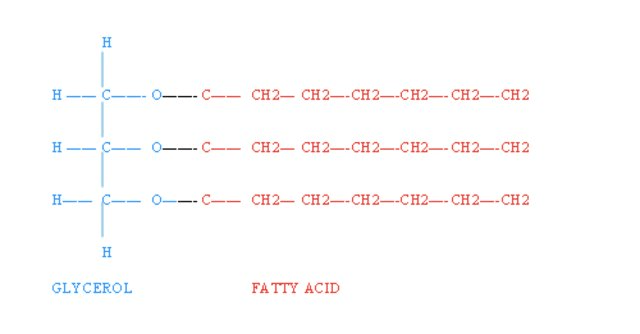Which 3 atoms are carbohydrates composed of?
carbon
hydrogen
oxygen
All fats belong to this diverse class of organic substances that are insoluble in water
lipids
The building blocks of protein
amino acids
How many kcal are in 100g of carbs?
400
When a nutrient cannot be synthesized in the body and thus must be obtained in the diet, we refer to it as
essential
The nondigestible part of plants that form the support structures of leaves, stems, and seeds
dietary fiber
The shape of saturated fatty acids allows them to stack well together, which means that at room temperature, they are
solid
How many amino acids are essential amino acids?
9
How many kcal are in 11g of fat?
99
This is the most abundant carbohydrate and is produced by plants through photosynthesis
glucose
Animals store glucose as polysaccharides in the form of
glycogen
The fats that we can see in foods are known as
visible fats
Significant chemical digestion of proteins begins in the
stomach
How many kcal are in 25g of protein?
100
The process of combining 2 or more incomplete protein sources to make a complete protein
mutual supplementation
The AMDR for carbs
45-65%
The AMDR for fat
20-35%
The AMDR for proteins
10-35%
A meal comprised of 100g of carbohydrates, 100g of protein, and 100g of fat would provide how many kcal of energy?
1700 kcal
The term for when proteins uncoil and lose their shape
denaturation
This enzyme breaks down carbohydrates and is produced in the pancreas and the salivary glands
amylase
This process involves the addition of hydrogen atoms to unsaturated fatty acids and often creates trans fatty acids; it was developed in the early 1900s as a way to produce foods that resist rancidity
hydrogenation
The creation of new proteins is called
protein synthesis
A meal comprised of 65g of carbohydrates, 15g of protein, and 21g of fat would provide how many kcal of energy?
509
This provides a measure of a food's ability to raise blood glucose levels
glycemic index
The production of "new" glucose from amino acids is known as
gluconeogenesis
This hormone triggers the breakdown of stored fat during exercise
adrenaline
This term describes the relationship between how much nitrogen (or protein) we consume and excrete each day
nitrogen balance
A meal comprised of 35g of carbohydrates, 10g of protein, and 15g of fat would provide how many kcal of energy?
315
Plants store glucose as polysaccharides in the form of
starch
Where is glycogen stored in our bodies?
liver and muscles
Eicosapentaenoic acid (EPA) and docosahexaenoic acid (DHA) are examples of which kind of essential fatty acids?
omega-3 fatty acids
A protein-energy malnutrition characterized by edema and distention of the belly
Kwashiorkor
For someone who ate 2000 kcal total, 150g of protein would represent what percentage of that day's caloric intake?
30%
Name the 3 types of complex carbohydrates (polysaccharides)
starch
glycogen
fiber
What does the term "enriched" on a food label mean?
nutrients in the food were lost during processing and then added back in.
The 3 major classes of dietary lipids are
triglycerides
phospholipids
sterols
In the stomach, pepsinogen reacts with hydrochloric acid to create this protein-digesting enzyme
pepsin
Jimmy ate 300g of carbs on a day he ate 2400 total kcal. What percentage of his day's caloric intake was represented by carbs?
50%
Condition in which infected pockets form on the wall of the large intestine
diverticulosis
Glucose and galactose combine to make this disaccharide
Lactose
These lipoproteins are the transport vehicles that remove absorbed fats from the small intestine
chylomicrons
Provide an example of how denaturation can be harmful
when critical body proteins are exposed to heat (e.g. fever) or acidity (e.g. blood pH out of normal range), causing loss of function
Maria ate 2500 kcal total and 100g of fat on Wednesday. What percent of her day's caloric intake was represented by fats?
36%
The term for any disorder caused by inadequate intake of primarily protein
protein-energy malnutrition
The monosaccharides glucose and fructose combine to make this disaccharide
sucrose
Products of fat digestion combine with bile salts to form _______, which transport lipid digestion products to the enterocytes.
micelles
Provide 2 reasons why someone might have a negative nitrogen balance (nitrogen consumption < nitrogen excretion)
starvation
very low energy diet
severe illness
infections
certain injuries
Sal consumed 2078 kcal on a day he ate 207g of carbohydrates, 90g of fat, and 110g of protein.
Determine what percentage of his day's caloric intake was represented by EACH macronutrient. (Round to nearest whole percentage. All responses must be correct to receive points)
Carbs - 40%
Fats - 39%
Proteins - 21%
The below image depicts what kind of lipid?
triglyceride